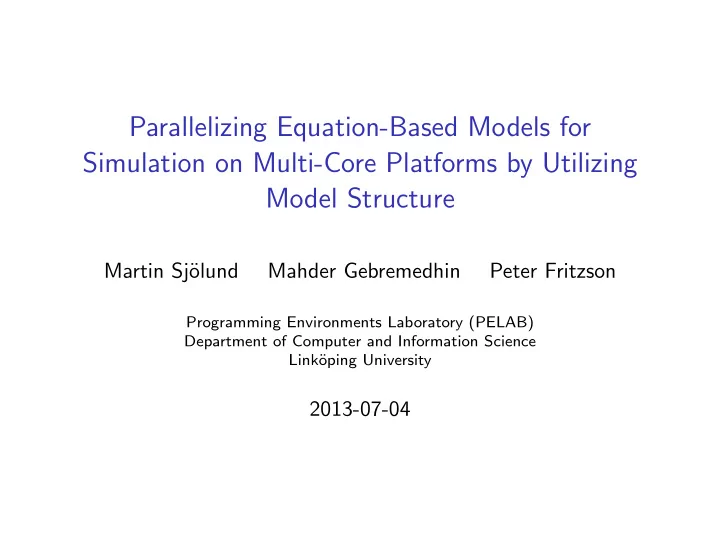

Parallelizing Equation-Based Models for Simulation on Multi-Core Platforms by Utilizing Model Structure Martin Sj¨ olund Mahder Gebremedhin Peter Fritzson Programming Environments Laboratory (PELAB) Department of Computer and Information Science Link¨ oping University 2013-07-04
Part I Background
Equation-Based Modelling and Simulation ◮ Declarative and acausal – describe the problem instead of the solution ◮ Symbolic manipulations ◮ Numerical methods and solvers
◮ An equation-based object-oriented language ◮ Primarily used to model and simulate (multi-domain) physical systems ◮ Easiest explained through an example
RC Circuit Example: Different Representations r C=1e-6 + R=1e6 pv c - model RC g import Modelica.Electrical.Analog.Basic ; import Modelica.Electrical.Analog.Sources ; Basic.Capacitor c; Basic.Resistor r; Basic.Ground g; Sources.PulseVoltage pv; equation connect(pv.n,g.p); connect(r.p,pv.p); connect(g.p,c.n); connect(r.n,c.p); end RC;
RC Circuit Example: Results 250 c.v pv.v 200 r.v 150 100 Voltage [V] 50 0 -50 -100 -150 0 1 2 3 4 5 time [s] Figure: Simple RC circuit simulation with input square wave pv.v, capacitor voltage c.v, and resistor voltage r.v.
Sorting and Matching ◮ There exists many valid solution paths ◮ v = r ∗ i ◮ i = v / r ◮ r = v / i ◮ ... ◮ We will not use an integrated approach ◮ Normal sorting+matching, then parallelize ◮ Parallelize, then sort+match
OpenModelica ◮ Open source Modelica tool ◮ Open Source Modelica Consortium (OSMC) ◮ Many partners ◮ Main development at Link¨ oping University ◮ Used for research prototypes and industrial products
Part II Parallelisation of Equation-Based Models
Single-Core Solution
Recommend
More recommend